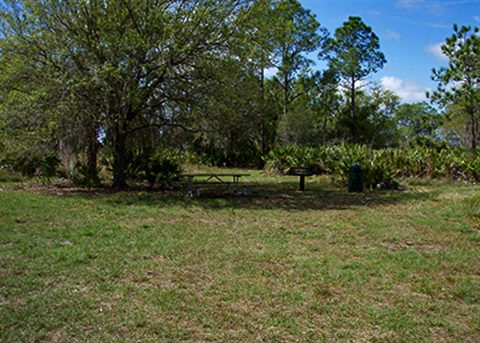Camp Lonesome Conservation Area
Announcement
Prescribed burns are a vital management tool to clear vegetation, recycle nutrients, and protect natural resources while reducing wildfire risks. During burns, parts of the property will be temporarily closed for safety. For updates on burns and closures, please register for Alert Osceola and opt in for Prescribed Burns. Thank you for helping us manage our environment safely.

Opt-in for Prescribed Burn alerts
In November 2007, Osceola County purchased the Camp Lonesome Conservation Area with funds from the Environmental Lands Conservation Program, formally known as Save Osceola. The property is 2,443 acres in size and was previously used for cattle production. This beautiful piece of "old Florida" landscape is south of St. Cloud and east of Canoe Creek Road.
The property supports several imperiled or rare ecological communities and wildlife species. Camp Lonesome is an excellent mosaic of mixed hardwood wetland swamps, wet prairies, cypress ponds and pine flatwood communities. Wildlife on site consists of white tailed deer, wild turkey, gopher tortoises and variety of bird species, including crested caracara, barred owl and Eastern meadowlark.
Approximately 75% of the Camp Lonesome ecosystem is fire-dependent, meaning it requires prescribed fire to properly maintain the land. Fire opens the understory for new vegetation growth and returns carbon to the soil, which enriches the soil for further growth. Prescribed fire also reduces the fire load, therefore reducing the threat of wildfires.
Camp Lonesome is open to the public for passive recreational use and serves as a preserve for native wildlife and vegetation habitat. It includes 4.5 miles of equestrian riding and hiking trails. For safety and security purposes, Camp Lonesome is accessible by reservation only. Please call 407-742-0200 to reserve your visit, or reserve online now.
Primitive and Equestrian Camping Rates
| Type |
Rate |
| Resident |
$12 per person, per night |
| Non-resident |
$15 per person, per night |
Reservation Information
- Day Hiking and Horseback Riding are permitted during park hours. For safety and security purposes, the entrance gate to Camp Lonesome is kept locked. For reservations you can call (407) 742-0200 or email parks@osceola.org.
- Overnight primitive camping and overnight equestrian camping can be reserved for up to 2 nights.
- Organized Groups cannot exceed 6 person.
Reserve Online Now
Documents
Photos
Prescribed burn FAQs
What is a prescribed fire and why do we need it?
Prescribed fire is a land management tool used to restore and maintain fire-dependent ecosystems, enhance forest health, improve wildlife habitat, and reduce the chances of dangerous, uncontrolled wildfire by decreasing hazardous fuels.
Fire promotes healthy ecosystems by clearing out competing vegetation, cycling nutrients into the soil, stimulating growth and seed production of fire-dependent plants, and providing food for wildlife.
One of the greatest benefits of prescribed fire is that it reduces “fuels” such as underbrush, branches, pine needles, leaves, and dead plant debris that build up on the forest floor over time. Reducing fuels every few years helps reduce the intensity, heat, and destructive force of a wildfire if one occurs.
Who conducts prescribed fires on Osceola County-managed land?
Prescribed fires are carefully planned. Depending on the location of the prescribed fire and the requirements of the burn plan or prescription. Osceola County staff, contractors, and Florida Forest Service (FFS) conduct the burns using a “prescription” that has been written specifically for the area to be burned.
How will I know when a prescribed fire is going to take place?
County staff will place roadside signs near a prescribed fire site on the day of the scheduled burn. Notices may be posted on social media for the affected communities. You can sign up to receive alerts and opt-in for Prescribed Burn notifications.
Changes in local weather conditions often require last-minute changes to the prescribed burning schedule.
What happens to wildlife during a prescribed burn?
The safety of wildlife is always a concern during prescribed fires. Prescribed fire plans are prepared to account for wildlife safety, and prescribed fires are conducted to allow animals to seek safety during the relatively slow-moving prescribed fires.
Some animals take refuge by moving to unburned or previously burned areas. Small animals seek shelter under logs, in old trees, and in burrows like those of the gopher tortoise.
Few animals are harmed by prescribed fire, especially during the growing season when the weather is warm and most animals are active. Ground nesting birds build new nests, and benefit from an increase of insects resulting from new plant growth after the fire.
Fast-moving, high-heat wildfires usually do not provide the same opportunity for wildlife to escape.
How long does a prescribed fire last?
Most prescribed fires last only one day. However, it is sometimes beneficial to the environment to let a fire continue into the night or the next day if the area burning is secure, and the smoke will not negatively impact the community.
How long does the smoke remain?
Concerns regarding smoke created by prescribed fire are a priority, especially for the residential areas surrounding many nature preserves in Osceola County. The prescribed burn teams take precautions to limit the amount of smoke produced by the fire. Some light smoke, haze and small flames may remain in the area of a prescribed fire for several days or longer.
What precautions should I take if I live near an area to be burned?
Here are some tips to help you minimize impact to yourself and your home:
-
If you have health issues that can be aggravated by smoke, such as asthma, allergies, or respiratory ailments, limit outdoor activity, or temporarily leave the area during and immediately after the burn
Location
4257 North Canoe Creek Road, Kenansville, FL 34739 View Map
28.0217902,-81.201137
4257 North Canoe Creek Road ,
Kenansville, FL 34739
4257 North Canoe Creek Road ,
Kenansville, FL 34739
Camp Lonesome Conservation Area